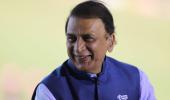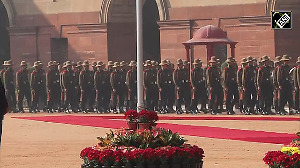K N Prabhu, the doyen of cricket writers, salutes Sunil Manohar Gavaskar, who appeared for the first time in Test cricket 50 years ago today, March 6, 1971.

This feature was first published on Rediff.com on July 9, 1999.
According to C P Snow, the great mathematician G H Hardy, who encouraged our own genius Ramanujan, was a keen follower of cricket and was apt to judge his contemporaries and other players by certain standards.
To him, the highest standard was the Bradman class.
If we were to accept this practise for ourselves, it would have to be the Gavaskar class.
The comparison with Bradman is inevitable, considering the statistics.
Bradman was nearly 22 when he made his presence felt with a series of tall scores in his first Test series in England in the summer of 1930.
And just as celebrated was Gavaskar's arrival round about the same age on his first tour of the West Indies in early 1971.
His scores of 65, 67 not out, 116 and 64 not out, 1 and 117 not out, 124 and 220 were Bradmanesque in proportion.
Luck, too, attended both the master batsmen.
It is said that when Bradman made his record score of 334 at Leeds, the first ball he faced, from Maurice Tate, all but bowled him.
And before Gavaskar had settled down in the Trinidad Test, Sobers, of all people, dropped a sitter off his bat in the slips.
It is as if Fate was on Gavaskar's side from the very start, for his uncle had detected that the crib in which he had been placed at birth had been exchanged for one occupied by a fisherman's child.
Gavaskar was certainly destined for greater things than casting his net in the Arabian Sea.
The comparison with Bradman goes further.
Gavaskar, like Bradman, was very much in the public eye, whether it was controversy on the field or off it.
Such was Gavaskar's influence that he was able to get away with it.
Bradman is said to have had problems with some of his team-mates, and so did Gavaskar, for it is no secret that he didn't see eye to eye with Kapil Devi and Bishen Bedi.
Gavaskar, like Bradman, was very much a public figure, winning the highest of national and state awards.
But for all that, he is easily accessible, though he doesn't suffer fools gladly.
He has the charm and the ability to disarm his critics and win friends with witticism and on tours abroad, one had to watch out for the practical jokes played or inspired by him.
I remember how he once got us to evacuate the Windsor Hotel's dining room just when we were settling down to savour some good wine, with a report of a bomb threat.
And later at Wellington, all the members of the side had to jump out of bed at midnight and take to the streets at the sound of a fire alarm.
He is also an excellent mimic, and his impersonations of Board members and fellow players enlivened our evenings.
As a writer and broadcaster, he has brought his immense knowledge to bear on reading the game, expressing himself clearly and with all the vision that during his playing days enabled him to see the bowling for what it was.
As a captain, Gavaskar looked a born leader, even during his apprenticeship under Wadekar when, from the slips, he showed his understanding and appreciation of good bowling and fielding.
He himself was an outstanding performer in the slips, where he finished up with 108 catches.
In his early years as captain he was often faulted for his tactics and for his virtual neglect of spin bowlers Shivlal Yadav and Dilip Doshi.
But he graduated with honours in the home series of 1981-1982 when he made Keith Fletcher, that most professional of captains, look like an amateur.
Gavaskar's batting records are amazing by any standards.
Apart from being the first to score 10,000 runs in Tests, he had set the record of 774 runs at an average of 154.8, the highest for any batsman in his debut series.
And when comparisons are made with other run-getters, it must be remembered that Gavaskar never had an easy series in his career.
All his runs were made against the quick bowlers of Australia, England, West Indies, Pakistan and New Zealand.
They were made in the opening position, against "pace like fire".
And in the latter stages of his career he had to contend with bowling which bordered on the shadowline between the genuinely fast and fast, and the short-pitched ball that is meant to intimidate.
And for a long part of his career, he had to virtually go it alone.
It was only when Chetan Chauhan, and then Krish Srikkanth, came on the scene that he had someone to share "the burden and the heat of the day".
Wisden, while nominating him in its top five for 1980, summed up his batting as follows: 'When he sets his sights high he builds his innings with meticulous care, limiting himself to the strokes he knows best -- drive through the covers, past the bowlers and between mid on and midwicket.
'But when he lets his hair down, his range of shots and the power behind them are astonishing.'
The shrewdest analysis came from Ted Dexter, who ascribed Gavaskar's succcess to his playing the game with the 'broadest bat' in the world.
He wrote that Gavaskar had the 'broadest bat in the game', and defined this metaphysical concept as 'the ability of a great batsman to make more use of the width of his bat than the others.'
That 'broad bat' was very much in evidence when he played what he claims was his best innings -- 54 in the gloom of Old Trafford in 1971.
But there are two others which I witnessed and which I felt were typical of the man -- his 71 in the second innings of the Christchurch Test of 1976, which contained three hours of disciplined batsmanship which was ended by Howarth's superb catch in the gully; an innings played on a pitch of unpredictable pace and bounce and it saved the day for India.
I am also inclined to grant the palm to him for his knock of 107 in the December Test of 1978 in Calcutta against the West Indies; in the humid bowl of Eden Gardens.
Phillip, Clarke and Marshall made the ball swing in the air and seam off the pitch, and Gavaskar played it all with the assurance of a master who knows where his off stump is.
There was a time when critics noticed a 'corridor of uncertainity' in this area whenever he played bowlers like Lillee and Hadlee, but he had the power and ability to steer himself out of harm's way.
And finally there was the masterly innings of 96 on a turning track against Pakistan in the Bangalore Test of 1987 which dispelled any doubts about his ability to deal with spin on a receptive wicket.
The essential secret of Gavaskar's success lay in his quick footwork and admirable sense of timing.
He arrived at the highest level just when India needed someone of calibre to sustain the batting.
He said farewell to the game with a century in the Biennial Test of August 1987 at that holy of holies, Lord's, to secure the only distinction that had thus far eluded him.










